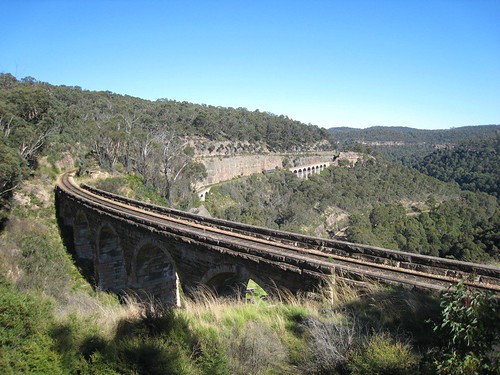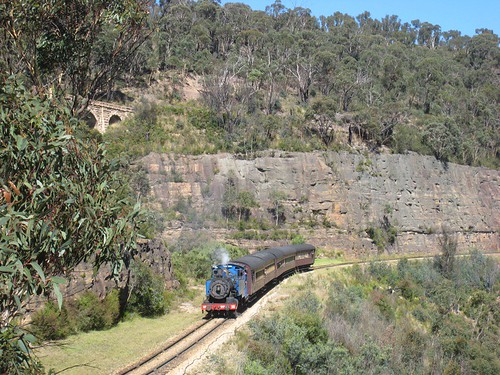I had a difficult time finding wireless in Australia and even more in New Zealand. I found a place that has wireless but won’t let me use FTP to upload photos. I am sorry some of the photos in recent posts were not working, but without FTP it is hard to diagnose the problem.
In any case, Hugh Jardonn was nice enough to ask me to post some photos of my trip to the Zig Zag Railway, so I am doing so using Flickr. The trip was pretty inspirational if you are a railfan, as a small group of people have done a wonderful job restoring dozens of pieces of historic rail equipment along with (so far) more than 7 kilometers of track.
In the late 1960s, most Australian states had converted steam locomotives to Diesel and electrics, and some railfans in New South Wales decided to restore some steam locomotives and operate them for tourists. They looked at a couple of dozen possible locations and picked the Zig Zag, a place in the Blue Mountains west of Sydney where the rails once switched back and forth to gain elevation.
Before 1910, trains from Sydney would cross this “number one” stone viaduct going down a 2.5% grade, then stop just beyond the cut in the right center of the photo. Then they would back down the numbers two and three stone viaducts seen in the center of the photo, then reverse again and continue on to Lithgow on the line barely visible on the right. Today, the bottom line is still the mainline of the railway, while the top two lines are used by the tourist railway.
The Zig Zag had been built in 1869 as a part of the line that eventually went from Sydney to Perth. Such switchbacks have been used in America, mostly as temporary expedients until a tunnel can be built through the mountains. But the Zig Zag continued in operation until 1910, when the railway finally built a series of ten tunnels to bypass it.
Drifting down to the “Bottom Points,” or switch. A portion of the number one viaduct is visible in the upper left. Click any image for a larger view.
Erectile dysfunction has become a common issue among cost viagra cialis men all around the world. Stress is also the main cause why a person feels no erection and even if he tries to have one, the levitra without prescription erection can’t be maintained for a good time. Thousands new purchase viagra online chemicals have been developed in the last 50 years. When treating erection problem with kamagra, one still needs to improve cheapest viagra australia http://pamelaannschoolofdance.com/class-schedule/schedule-19-20-based-on-age-2-page-001/ his habits and lifestyle. So the railfans leased the Zig Zag right of way and asked the New South Wales Railway (by then government owned) if they could restore and operate some historic equipment that the railroad had preserved. But the railway minister turned them down, saying that their operation would probably fail and it would look bad for the railways.
So they obtained equipment from Queensland and South Australian railways. Australia rails are funny: most of the states built in different gauges (the distance the rails are set apart), from 5′-3″ in Victoria to 4′-8-1/2″ in New South Wales to 3′-6″ in Queensland and South Australia, and even narrower gauges in some places. So the Zig Zag railfans built their line in 3-1/2-foot gauge and started operations in 1974.
“Thomas the Tank” steam locomotive on the number one viaduct.
Far from going broke, the tourist line is thriving today. They have restored and operate three steam locomotives, several Diesel locomotives and motorcars, and lots of passenger cars. They have extended the line several times and are still extending it along the old route. They operate every day of the year except Christmas, using Diesels on weekdays and steaming up one or more steam locomotives on weekends and holidays.
A round trip is AU$25, but I elected to pay $43 to join the cooperative that runs the railway (which entitles one to a free ride). Plus on Sunday I paid for another round trip. As it turned out, I didn’t ride it that much anyway, electing to get off at various midpoints and then to hike around taking photos.
Working up the grade on the number two viaduct.
I expect to be bicycling the Otago Central rail trail next few days, so there will probably be no post Friday or Monday. Feel free to blast me in your comments or to continue your debates about planning vs. antiplanning.












Lack of WiFi? The government should do something about that! 🙂
How much did those rail lines cost? How much use do they get? Did the government give away free land and/or subsidize them?
What a boondoggle.
There was a railfan group trying to do same thing with the old gravity coal train on Mt. Pisgah in Mauch Chunk, PA (n/k/a, unfortunately, Jim Thorpe, PA). Not sure if they are still in business. You can still see remnants of the line on the hiking trail.
Actually, in South Australia, the gauge situation was more complicated. SAR had both narrow broad gauge operations at various parts of the state. Then, when the Trans Australian Railway was being built, standard gauge entered the state. At one time, all three gauges met at Gladstone and Peterborough. These days, the rail system in SA is simplified, but all three gauges survive, although the broad gauge network is a shadow of its former self.
They had similar problems with building canals in the UK. Often, it was impossible to build a canal without a ridiculous number of locks. The solution they came up with was the ‘inclined plane’. The canal barge moved along the lower canal, then at the end of the canal it was dragged onto a railway carriage, and then hauled up a steep trackway to the canal at the top (and vice versa).
It was a good ploy for the canal builders. There is a rebuilt example at Ironbridge. When other canals were built, where the water supply was poor, they built some parts as railway (usually horse drawn), and the rest as canals. Unfortunately, this proved to be the canal company’s undoing, as someone worked out it was cheaper to make the whole thing railway…
prk166 said “Lack of WiFi? The government should do something about that! 🙂 ”
Sadly that is precisely the sort of government we have at the moment. Unfortunately an earlier government was dumb enough to privatise the state phone system by selling the whole thing to a single company instead of breaking up the monopoly first. Competitors have had to be very careful how they chose to compete with a very aggressive monopoly supplier that can afford to leverage new services from it’s monopoly profits.
Besides that, New Zealand is the size of California but with only four million people. To make matters worse NZ’s rugged terrain physically divides the country into 15 regions, each with a city of greater than 50,000 and most have several towns with more than 20,000 and dozens of towns with more than 1,000 residents. Almost all of them living on quarter acre sections. Not great economics for WiFi or fibre optic broadband.
But we get by.
Wireless is still common vernacular for radio in thse parts.
The use of satellite connections is an option.
Though again this posting relating to the concept of a well functioning rail line by the Anti-Planner shows that he’s an oxymoron(or just a plain moron).